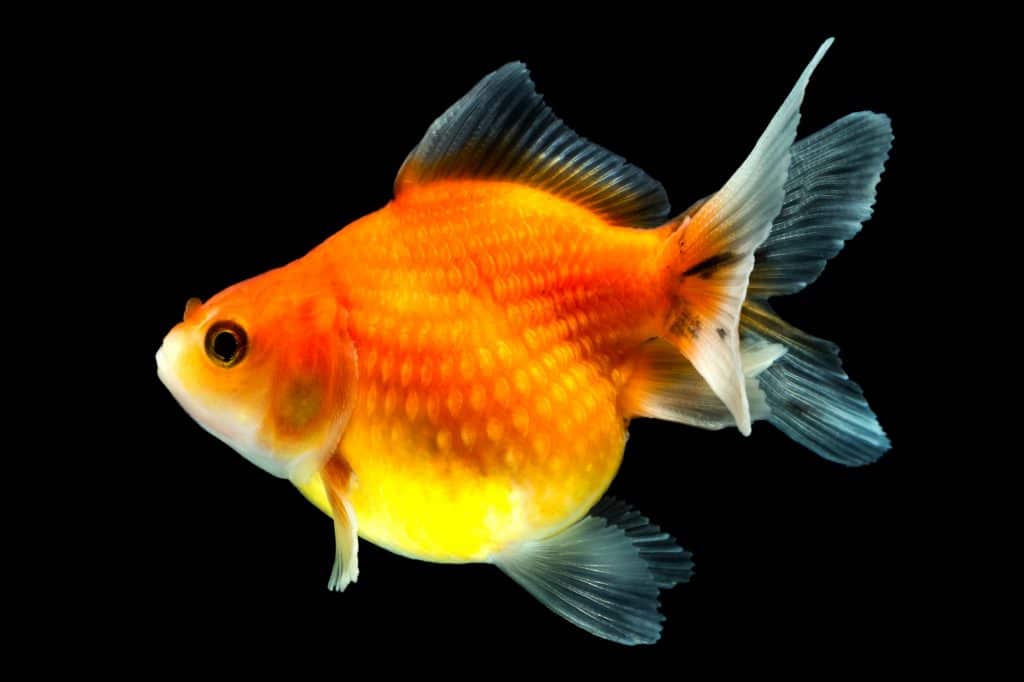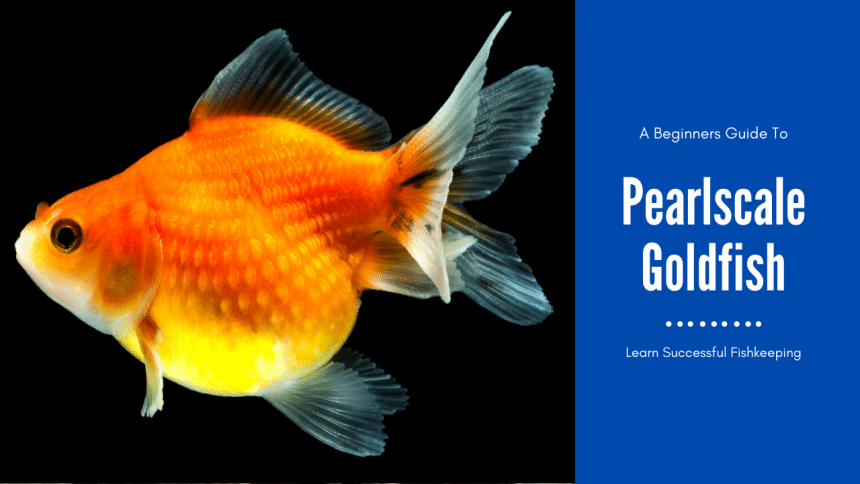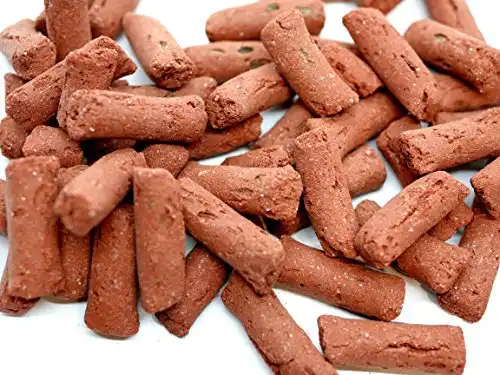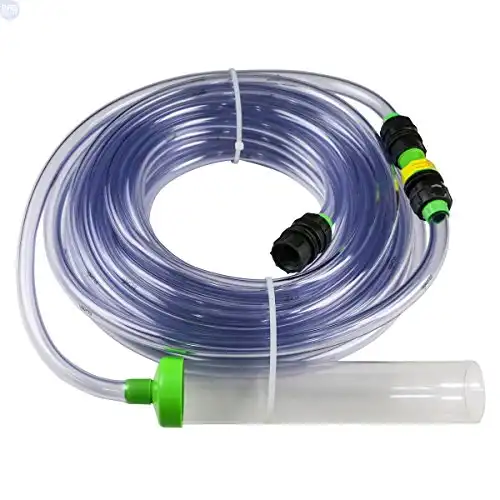Thank you for visiting! By the way… any links on this page that lead to products on Amazon and other stores/partners are affiliate links Aquarium Store Depot earns a commission if you make a purchase.
Pearlscale goldfish are a pretty common fish to see in pet stores, but they’re actually quite delicate and require more care than other varieties of goldfish. They have a lot of beautiful colors on their scales, which is why some people call them “scaleless” or “pearlscale.” The luminescent scales of the egg-shaped pearlscale goldfish make it one of the most sought-after freshwater fish for a beginner fish keeper. I’ll be going over the basics of feeding, tank size, water quality, and tank mates.
I hope from reading that this will make caring for your pet fish much easier. So if you’re thinking of adopting these cute fish, you’ve come to the right place—find our comprehensive care guide below!
Species Overview
| Scientific Name | Carassius Auratus |
| Common Names | Golfball pearlscale, pearlscale goldfish, ping-pong goldfish |
| Family | Cyprinidae |
| Origin | China |
| Diet | Omnivore |
| Care Level | Easy |
| Activity | Moderately Active |
| Lifespan | 5 to 10 Years |
| Temperament | Peaceful |
| Tank Level | All levels |
| Minimum Tank Size | 20 Gallons |
| Water Temperature Range | 65°F to 75°F |
| KH | 4-20 |
| pH Range | 6.5 to 7.5 |
| Filtration/Water Flow | Moderate |
| Water Type | Freshwater |
| Breeding | Egg layers, can be bred in both small and large groups, can be hand spawned |
| Difficulty to Breed | Moderate |
| Compatibility | Peaceful community species, best with other Fancy Goldfish |
| OK for Planted Tanks? | Mostly No |
Origins and Habitat
Originating in the early 20th century, the pearlscale goldfish is a relatively new addition to the family of fancy goldfish. Unlike the slender common goldfish, the Chinshurin (as is their Japanese name) have an adorable rounded body, which increases their popularity.
Most species of goldfish are bred in China or Japan. However, modern day pearlscale goldfish are bred and developed mainly in England. But like most fancy goldfish, ping-pong goldfish are bred and kept all over the world. Because there are specially bred goldfish, there are no Pearlscale fish in existence in the wild.
What Does the Pearlscale Goldfish Look Like?

There are many ways to tell goldfish pearlscale apart from others:
Body
One of the first things you’ll notice when you lay your eyes on a pearlscale goldfish is its egg shaped round belly (many also compare it to a golf ball), which is offset especially by its compact and stubby body. In fact, this roundness is what inspires the “ping-pong goldfish” moniker.
Accompanying the short and rounded body are beautiful fins that flow ethereally in the water. They have a single dorsal fin, while the rest of the fins are paired. Of these, the twin tailed fin is the most remarkable, as it has a forked appearance.
The wen fish or crown pearlscale goldfish (named for the crown atop their head) have a slightly different appearance, with large and distinct bubbles on their heads. These might be given the name of high-headed or hooded pearlscales.
Scales
What truly sets the pearlscale goldfish apart are its distinct scales, which are nacreous (reflective and translucent tissue). These scales are caused by calcium carbonate deposits due to a genetic mutation. Arranged in visually pleasing rows, these scales have a shiny and luminescent appearance that have a pearl like appearance (and hence the name!), and a bead-like texture.
You won’t see these pretty nacreous scales until your goldfish are older, however. To the untrained eye, young fish of this goldfish species might be difficult to tell apart from the common goldfish.
Color
The golfball pearlscale goldfish comes in a wide variety of colors and patterns. Most commonly found are solid colored specimens, which might be covered in white, red, blue or black. Calico and chocolate brown varieties are also found of this beautiful freshwater pearlscale fish. There are many types of pearlscale goldfish available. The video below from Molly Babe Aquatics gives a great example of the variety out there.
How Big are They?
On average, a pearlscale goldfish will measure between 6 and 8 inches in length, and on rare occasions, 10 inches. One easy way to imagine their size is to think of the shape and size of oranges.
How Long do they Live?
The average lifespan of a pearlscale is between 5 and 10 years, which is less than their non-fancy varieties due to their genetic makeup. Rarely, some goldfish pearlscale species live up to 15 years. It’s important to note the health problems that some pearlscale goldfish might be exposed to in suboptimal living conditions. That’s why it’s important to know how to set up their tanks for maximum life and health.
Temperament and Activity Level
One of the reasons why pearlscales are so popular as pets is their docile and peaceful temperament. Furthermore, they’re slow moving, slow swimmers. Because of this, they are relatively low-maintenance, and they don’t exhibit aggression.
Pearlscale goldfish are quite easy-going compared to other freshwater fish, preferring to spend their days swimming about slowly (unlike, for example, wakin goldfish who are known for fast swimming). However, just because they’re not fast swimmers doesn’t mean they have a low activity level: sometimes, they like to explore and play, so it’s a good idea to put them in a sizeable goldfish only tank.
What are Good Tank Mates?
Thinking of putting some pearlscale goldfish into an existing aquarium? Consider what fish make good tank mates for them, and which ones don’t:
Good Tank Mates
If you have a peaceful community aquarium, great news! Some pearlscale goldfish will make a wonderful addition to it, as they can cohabitate easily with other fancy goldfish and docile freshwater fish. Here are some good tank mates for pearlscale goldfish:
- Black moor goldfish (or other telescope goldfish)
- Fantail Goldfish
- Oranda Goldfish
- Lionhead goldfish
- Ranchu Goldfish
Other than fish, certain snail species also go well with pearlscales, such as mystery and nerite snails.
Fish Species to Avoid

As mentioned before, goldfish pearlscales are slow swimmers. As such, it’s important to keep them away from fast swimming and aggressive fish, because they might end up nipping at the fins of your pearlscales and out competing them for food. Accordingly, here are some fish species you should avoid putting in with your pearlscales:
- Comet goldfish
- Wakin goldfish
- Shubunkin goldfish (pictured above)
- Koi Fish
Furthermore, note that many tropical fish should not share the same aquarium as your pearlscales, as they have different temperature requirements. Even if no fin-nipping occurs with tank mates, feeding time will be difficult for your pearlscale goldfish if the tank mates are fast.
What do They Eat?
As omnivores who thrive on a healthy diet, pearscale goldfish will readily accept most food that you give them. The best kind of readymade food to give your pearlscales is calcium-fortified dry pellets and dry flakes, but only after it’s been soaked. This is because they have a sensitive digestive system and are prone to developing swim bladder disease.
Pearlscales love vegetables, such as cucumbers, frozen peas (as well as deshelled peas), and lettuce. These are great for pearlscales as they keep intestinal problems (such as constipation) at bay. Make sure to steam vegetables before feeding them to fish to sterilize them
Furthermore, limit protein for your pearlscales; it should make up only about 30% of their diet. Excessive protein can cause health complications for pearlscales.
What About Live Foods?
You can include live foods in your pearlscale’s diet every now and again. Brine shrimp, Daphnia, blood worms, blackworms, or Tubifex worms are good live food options for your pearlscale goldfish. Keep in mind the risks of diseases when feeding live food. The safest way to feed live food is to cultivate your own, but this is not for everyone.
How Much and How Often to Feed
A balanced and healthy diet for a pearlscale goldfish will be one made up of a mix of high quality frozen, pellets, and flakes which are given to them at least twice a day. Only feed what your fish can eat in 2 minutes to avoid any excess food in the tank.
Tank Requirements
Fish Tank Size
The recommended minimum size for a pearlscale goldfish aquarium is 20 gallons—even better if you can make it 30.
This is because, although they’re weak swimmers and slower swimmers than other similar goldfish species, pearlscales do like to swim around their aquarium. More importantly, they need a lot of oxygen and produce a lot of waste. A general rule of thumb is to add 10 gallons of tank capacity for every one fancy goldfish after the first 30 gallons.
Tank Setup
Here are some particulars on setting up a freshwater aquarium for your pearlscale.
Substrate
A sandy substrate is the best option if you want to create a natural environment for your pearlscales. This is to mimic their natural environment as pearlscales enjoy digging through their substrate. If you go with gravel, it’s important to ensure that you’re getting larger and smoother gravel substrate. Otherwise, they might accidentally swallow some.
Decor
One of the defining characteristics of pearlscales is that they have very delicate and breakable scales. This is why it’s important to avoid putting them in a crowded aquarium. If your existing tank has many decorations and aquarium rocks with sharp edges (or any other sharp objects), it’s best not to put your pearlscales in it as they might accidentally bump into them and have their scales fall off.
If this happens, the fish will not regain its original “pearl” scales; instead, regular scales will grow in their place (although some aquarists say that additional calcium helps here, this is undocumented). That said, aquarium driftwood and plants are okay. You can smooth out driftwood with sandpaper and cut off sharp edges.
Plants
Plants are a great addition to a pearlscale goldfish aquarium, because these fancy goldfish love darting in between and playing with live plants. In fact, a natural pond-like habitat is very good for pearlscales. If you want to put live plants with your pearlscales, go with cold-hardy and beginner plants like Java fern, Hornwort, Anubias and Anacharis. Goldfish in general do not have an appetite for Java Fern and Anubias, but every individual fish is different.
Editor's Choice
Hardy, easy to care for, and requires only basic lighting to grow. This is the perfect aquarium plant for beginners!
Pearscale Goldfish Care (Water Quality)
Nutrition, clean water, and stress management are the keys to proper Pearlscale goldfish care. Let’s focus on filtration and maintenance.
Filtration
In the case of pearlscales, biological filtration is best as it allows for a high level of water quality, which keeps them safe from common aliments and stress.
With a decent filtration system, both your fish’s waste and leftover food will be dealt with. This is particularly important because pearlscales are slow eaters and tend to take their time to get to their food. A hang on back filter at minimum are best to use given the high bioload these fish add to an aquarium.
A canister filter should be considered for larger fancy goldfish tanks. Their large mature bulky mature sizes and general foraging habits tends to generate a lot of waste particles in the water that need to be filtered out. A large filter like a canister will ensure mechanical filtration is top tier and nutrients can be processed appropriately.
In fish only fancy goldfish tank, a complete media like biohome is an ideal solution for keeping nitrates down when pairing with a canister. Biohome is amazing for high load fish only tanks – such as a large fancy goldfish tank.
Editor's Choice!
This is the best media you can buy for your aquarium. It does it all - removes ammonia, nitrite, and nitrates
Water Parameters
As the species of pearlscale goldfish isn’t naturally occurring, there is no natural habitat you can emulate for them in your tank. However, their preferences are well known. They can withstand a wide temperature range, and do well in cold water and neutral pH levels. Watch out for frequently fluctuating pH levels as this can cause disease and ill health. Nitrates is also a common issue with fancy goldfish tanks. Regularly testing your water will assist in determine the water change volume and frequency.
Here are some specifics:
- Water Temperature: 65.0 to 75.0° F
- pH Range: 6.0-7.5
- Hardness Range: 4 – 20 KH
- Salinity: Below 10% (with a specific gravity below 1.002)
- Water Movement: Moderate
- Nitrates: Keep below 40
Aquarium Maintenance
The tank you place your pearlscale goldfish in should be well-maintained if you want them to stay healthy. Scheduled weekly water changes of 1/4 to 1/3 are required as pearlscales produce a lot of waste. As mentioned earlier, you can also choose to include snails in the tank as they make short work of algae and help to keep the tank clean. Since goldfish tanks require a lot of regular cleaning, an investment in a tool like a python cleaner can help save you time.
The Python is a mainstay in the fish hobby. Easily clean your aquarium by connecting this to your sink!
How to Set Up Your Fish Tank
Beyond providing a good filtration system for your pearlscale goldfish’s tank, consider the following set-up requirements:
Tank Size
As you already know, at least 30 gallons is required for housing a pearlscale goldfish, with an additional 10 added for each new goldfish you introduce into the tank. This large amount of water is required so that the waste is diluted, and it lets you keep water changes scheduled to once a week.
Tank Shape
A large surface area is optimal for keeping fancy goldfish as it prevents an oxygen shortage. Remember, the tank shape determines the surface area; as such, it’s best to go with an elongated tank as opposed to a tall one. If you want a round or oval tank for your goldfish, it should be narrow at the top and wide in the middle for maximum surface area.
How to Breed
In the right conditions, pearlscale goldfish can spawn easily and readily. They are egg layers who can breed in small groups as well as large ones.
Breeding Conditions
Start by providing a breeding tank that is at least 20 gallons. A few weeks before breeding, make it a point to separate the males and females as this will increase their interest to spawn. When you’re ready, release the males and females in at the same time. Avoid rough handling.
Drop the temperature slowly to around 60°F, then gradually warm it at 3°F until spawning occurs. Usually, when the temperature is between 68° and 74°F, spawning will begin. This is a good time to feed your pearlscales live food such as worms and brine shrimp. Try to feed at least thrice a day. As for water changes, you should aim to make partial changes of about 20% per day.
How to Tell if Your Pearlscales Will Start Breeding
As the tank temperature increases, the male pearlscale will chase the female around (not aggressively) for several days. Both males and females will have a vivid, more intense color.
If you see a gyrating action in your freshwater fish, that means they’re spawning. The female will be pushed against any plants inside the aquarium during the process, which will cause tiny eggs to drop out, which can then be fertilized.

The spawning process can last up to 3 hours and produce about 10,000 eggs. Once this is done, remove the goldfish from the breeding tank, because they will start trying to eat the eggs. In 4 to 7 days thereafter, you should have a brand new group of juvenile pearlscale goldfish.
Health and Disease
Signs of Health
If your pearlscales have shiny scales and eyes, are swimming about their tank most of the day, and feed periodically throughout the day, you can safely assume that they’re healthy and happy. They should also retain their round body shape.
Signs of Ill Health
If your fancy goldfish seem lethargic, aren’t eating much, have pale skin, are hollow-bellied, or have fraying fins or scale loss, that means their health or life expectancy is compromised. Here’s what might be ailing them:
Common Health Issues and Treatment
Pearlscale goldfish are prone to being afflicted by all common freshwater fish diseases, such as fin rot, ich, flukes and fungus.
Because pearlscale goldfish have long and flowy fins, they are particularly prone to fin rot, which mainly occurs in poor quality water. So to prevent this, you should aim to provide high quality water for your goldfish.
Swim bladder disease is another commonly occurring disease in pearlscale goldfish. This is due to the compactness of their intestinal tract, which is easily affected by taking in too much food or even air. I go over swim bladder, dropsy and other serious goldfish aliments in my freshwater fish diseases post.
Where to Buy
As a common fancy goldfish, pearlscales are readily available in most pet shops, both online and off. However, the finest pearlscales are typically imported from countries like China. It is best to work with a what you see is what you get (WYSIWYG) online fish store to get select varieties.
Closing Thoughts
After this post, you should have a better understanding of the care and maintenance required for pearlscale goldfish. If you’re interested in learning more about freshwater fish or if you’ve been considering getting one as your first pet, please leave me a comment below! I’m happy to answer any questions that may come up while reading this blog post.
- About the Author
- Latest Posts
I’m thrilled that you found Aquarium Store Depot! Here you’ll find information on fish, aquariums, and all things aquatics related. I’m a hobbyist (being doing this since I was 11) and here to help other hobbyists thrive with their aquariums! I adhere to a high quality Editorial Process and Review products with real life field usage and practical analysis.








